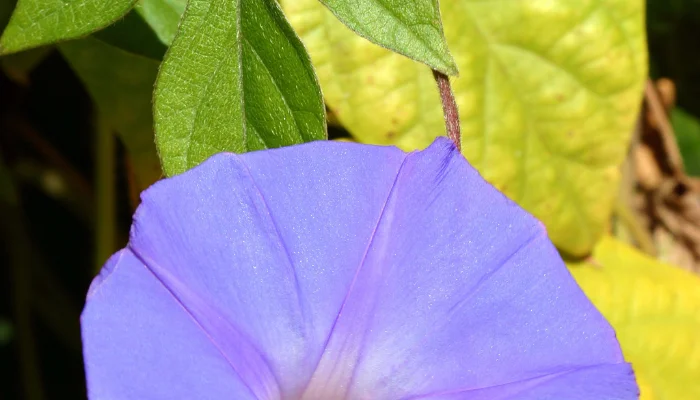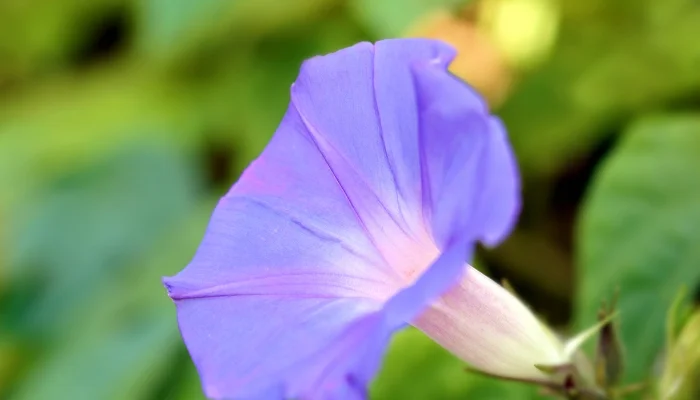The well-liked garden vines known as morning glories add color and happiness to our surroundings.
A vital component of their beauty and general health is their rich green foliage.
Yet, it can be concerning if you wake up one morning and discover that the leaves of your morning glory plant have turned yellow.
Yellowing leaves are a sign that your plant is not doing well.
Not to worry, we will cover all the possible causes of yellowing morning glory leaves and offer workable methods to help your plant get back to its former splendour.
Why Are My Morning Glory Leaves Turning Yellow?

Morning Glory Leaves Turning Yellow
Morning glory leaf yellowing can be caused by a number of things, and pinpointing the exact source will help you deal with the problem successfully.
Your morning glory leaves may be yellowing for a variety of reasons, some of which are listed below:
Nutrient Deficiencies
One of the most common reasons for morning glory leaves turning yellow is nutrient deficiencies. Plants, like all living organisms, require essential nutrients to thrive. When these nutrients are lacking, the plant’s leaves often display signs of stress, such as yellowing. The key nutrients to watch out for are nitrogen, iron, and magnesium.
- Nitrogen Deficiency: The growth of healthy leaves requires nitrogen. The older leaves may turn yellow first due to a nitrogen deficit as the plant redistributes nutrients to fresh development. You may solve this problem by fertilizing your morning glory with a fertiliser that is balanced and contains nitrogen.
- Iron Deficiency: Another typical reason for yellowing leaves, also known as chlorosis, is iron deficiency. The leaves will turn yellow, but the veins will continue to be green, making it easy to spot. This problem can be solved by adding chelated iron or iron supplements to the soil.
- Magnesium Deficiency: Magnesium is essential for the formation of chlorophyll, the pigment responsible for a plant’s green color. A lack of magnesium can lead to yellowing leaves with green veins. Epsom salt, which is rich in magnesium, can be dissolved in water and applied to the soil to alleviate this deficiency.
Improper Soil pH
Morning glories do best in soil that is neutral to slightly acidic and has a pH of 6.0 to 7.0. Yellowing leaves can result from the plant’s inability to absorb nutrients if the soil pH is too high (alkaline) or too low (acidic).
- Alkaline Soil: Essential nutrients may become locked up in alkaline soil, rendering them unavailable to plants. You can fix this problem by amending the soil with organic material, like as compost or peat moss, to lower the pH and increase nutrient accessibility.
- Acidic Soil: On the other hand, soil that is too acidic can prevent nutrients from being absorbed. Lime can be added to the soil to increase pH and enhance nutrient uptake.
Overwatering or Underwatering
Morning glories favor soil that is regularly moist yet has good drainage.
Overwatering can result in oxygen being deprived from the plant, soggy roots, and yellowing and wilting of the leaves.
Underwatering, on the other hand, might strain the plant and cause leaf discolouration.
To maintain the right moisture level:
- Ensure proper drainage in the planting area.
- Water your morning glory when the top inch of soil feels dry to the touch.
- Use mulch to help retain soil moisture and regulate temperature.
Pests and Diseases
Although morning glories are often resilient, they are nonetheless susceptible to a number of pests and diseases that can result in leaf yellowing. Aphids, spider mites, and fungal diseases are typical offenders.
- Aphids: By depriving the plant of vital nutrients, these tiny, sap-sucking insects can cause yellowing leaves. Using neem oil or insecticidal soap will help you get rid of aphids.
- Spider Mites: These minuscule arachnids can create webbing on the undersides of leaves, leading to yellowing and stippling. Regularly spraying your plant with water can help deter spider mites.
- Fungal Infections: Fungal diseases like powdery mildew and downy mildew can affect morning glory leaves, causing them to yellow and develop powdery growth. Fungicides may be necessary to combat these infections.
Environmental Stress
Plants that produce morning glory are susceptible to environmental stressors, which can cause leaf yellowing. Among these stressors are:
- Extreme Temperatures: Temperatures between 60°F and 85°F (15°C and 29°C) are ideal for morning glory growth. Stress on the plant and leaf discolouration can result from exposure to excessive heat or cold.
- Excessive Sunlight: Although while morning glories enjoy the sun, prolonged exposure to it in the hottest hours of the day will scorch the leaves and turn them yellow.
- Inadequate Light: On the other hand, a lack of sunlight can cause leaves to turn yellow. Make sure your morning glory gets 6 hours or more of direct sunlight each day.
Root Bound or Poorly Draining Containers
It’s crucial to make sure the container is the right size and the soil drains properly if you’re growing morning glories in pots.
Stress on the plant can result in yellowing leaves when the roots are crammed into a tiny space or when the soil holds too much water.
To remedy this:
- Move your morning glory into a bigger container with soil that drains well.
- A container should have adequate drainage holes to avoid waterlogging.
Age and Natural Leaf Shedding
Morning glory leaves can develop a natural yellowing and dropping process as part of the plant’s growth cycle.
Age causes leaves to lose their chlorophyll, turn yellow, and eventually fall off.
As long as it doesn’t harm a sizable percentage of the plant, this procedure is typical and you shouldn’t be concerned.
Final Thoughts
Beautiful, simple-to-grow morning glory vines may bring a touch of elegance to any garden.
It’s critical to swiftly look into the root causes when a plant’s leaves become yellow.
Some of the main causes include nutrient shortages, incorrect soil pH, hydration problems, pests, illnesses, environmental stress, and container troubles.
Monitor your morning glories’ growth frequently, give them the nutrients they need, keep the soil in the right conditions, and shield them from pests and other environmental stresses to make sure they stay strong and vibrant.
With the proper care, your morning glory vines will produce beautiful blooms and luxuriant green foliage year after year.
To restore these beautiful garden friends to their former splendor, keep in mind that patience and perseverance are essential.




